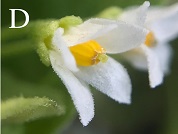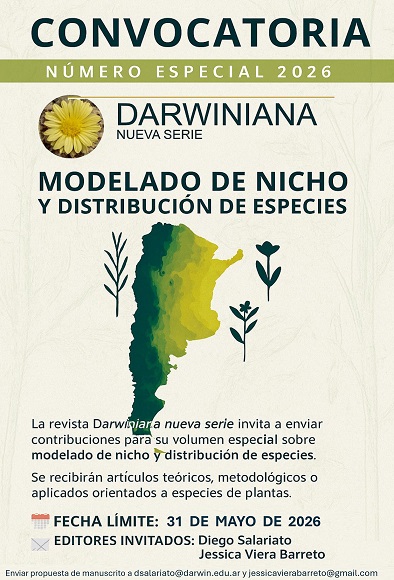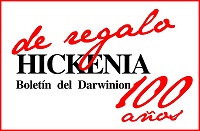Revalidación de Solanum sanfurgoi (Solanaceae), especie endémica de Chile central
DOI:
https://doi.org/10.14522/darwiniana.2025.131.1257Palabras clave:
Solanum, Flora mediterranea, Taxonomía, Endemismo, flora ribereña, NeotrópicoResumen
A partir de una iniciativa colaborativa centrada en el estudio de la biodiversidad local del río Mataquito, Chile central, se presenta el redescubrimiento y revalidación de Solanum sanfurgoi, entidad solo conocida por un ejemplar coleccionado en 1895, y considerado sinónimo de Solanum grandidentatum a partir del año 2023. Se entrega una descripción actualizada de la especie con su respectiva ilustración y una clave para el clado Morelloide en Chile central.
Citas
Bachman, S.; J. Moat, A. W. Hill, J. de la Torre & B. Scott. 2011. Supporting Red List threat assessments with GeoCAT: geospatial conservation assessment tool. ZooKeys 150: 117-126. DOI: https://doi.org/10.3897/zookeys.150.2109
Becerra, P. I. & J. A. Simonetti. 2013. Patterns of exotic species richness of different taxonomic groups in a fragmented landscape of central Chile. Bosque 34: 45-51. DOI: http://dx.doi.org/10.4067/S0717-92002013000100006
Beentje, H. 2012. The Kew Plant Glossary. An illustrated dictionary of plant terms. Kew Publishing, 164 pp.
Castillo, M. G.; H. J. Hernández & C. F. Estades. 2018. Effect of connectivity and habitat availability on the occurrence of the Chestnut-throated Huet-Huet (Pteroptochos castaneus, Rhinocryptidae) in fragmented landscapes of central Chile. Landscape Ecology 33 (7): 1061-1068. DOI: https://doi.org/10.1007/s10980-018-0649-5
Díaz, G.; P. Arriagada, K. Górski, O. Link, B. Karelovic, J. Gonzales & E. Habit. 2019. Fragmentation of Chilean Andean rivers: expected effects of hydropower development. Revista Chilena de Historia Natural 92: 1. DOI: https://doi.org/10.1186/s40693-019-0081-5
Díaz-Gavidia, C.; C. Barría, D. L. Weller, M. Salgado-Caxito, E. M. Estrada, A. Araya, L. Vera, W. Smith, M. Kim, A. I. Moreno-Switt, J. Olivares-Pacheco & A. D. Adell. 2022. Humans and hoofed livestock are the main sources of fecal contamination of rivers used for crop irrigation: A microbial source tracking approach. Frontiers in Microbiology 13: 768527. DOI: https://doi.org/10.3389/fmicb.2022.768527
Echeverría, C.; D. Coomes, J. Salas, J. M. Rey-Benayas, A. Lara & A. Newton. 2006. Rapid deforestation and fragmentation of Chilean temperate forests. Biological conservation 130 (4): 481-494. DOI: https://doi.org/10.1016/j.biocon.2006.01.017
Espinoza, S. E.; M. A. Yañez, E. E. Martínez, M. R. Carrasco-Benavides, S. A. Vaswani, J. Gajardo & C. R. Magni. 2021. Influence of provenance origin on the early performance of two sclerophyllous Mediterranean species established in burned drylands. Scientific Reports 11: 6212. DOI: https://doi.org/10.1038/s41598-021-85599-3
Frodin, D. G. 2004. History and concepts of big plant genera. Taxon 53 (3): 753-776. DOI: https://doi.org/10.2307/4135449
Gómez, P.; M. Murúa, J. San Martín, E. Goncalves & R. O. Bustamante. 2019. Maintaining close canopy cover prevents the invasion of Pinus radiata: Basic ecology to manage native forest invasibility. PloS ONE 14 (6): e0219328. DOI: https://doi.org/10.1371/journal.pone.0219328
Heilmayr, R.; C. Echeverría, R. Fuentes & E. F. Lambin. 2016. A plantation-dominated forest transition in Chile. Applied Geography 75: 71-82. DOI: https://doi.org/10.1016/j.apgeog.2016.07.014
IUCN. 2022. Guidelines for Using the IUCN Red List Categories and Criteria. Version 15.1. Red List Unit, Cambridge U.K. Available from: https://www.iucnredlist.org/documents/RedListGuidelines.pdf (accessed: 30 November 2022).
Knapp, S.; G. E. Barboza, L. Bohs & T. Särkinen. 2019. A revision of the Morelloid Clade of Solanum L. (Solanaceae) in North and Central America and the Caribbean. PhytoKeys 123: 1-144. DOI: https://doi.org/10.3897/phytokeys.123.31738
Knapp, S.; T. Särkinen & G. E. Barboza. 2023. A revision of the South American species of the Morelloid clade (Solanum L., Solanaceae). PhytoKeys 231: 1-342. DOI: https://doi.org/10.3897/phytokeys.231.100894
Meserve, P. L.; S. Gómez-González & D. A. Kelt. 2020. The Chilean Matorral: Characteristics, Biogeography, and Disturbance. In: Goldstein, M. I. & D. A. DellaSala (Eds.). Encyclopedia of the world’s biomes. Elsevier Academic Press, Amsterdam, pp. 594-601. DOI: https://doi.org/10.1016/B978-0-12-409548-9.11985-2
Miranda, A.; A. Altamirano, L. Cayuela, A. Lara & M. González. 2017. Native forest loss in the Chilean biodiversity hotspot: revealing the evidence. Regional Environmental Change 17: 285-297. DOI: https://doi.org/10.1007/s10113-016-1010-7
Moreira-Muñoz, A. 2011. Getting Geobotanical Knowledge. In: Moreira-Muñoz, A. (Ed.) Plant Geography of Chile. Springer, Dordrecht, pp. 47-84. DOI: https://doi.org/10.1007/978-90-481-8748-5_2
Myers, N.; R. A. Mittermeier, C. G. Mittermeier, G. A. B. Da Fonseca & J. Kent. 2000. Biodiversity hotspots for conservation priorities. Nature 403: 853-858. DOI: https://doi.org/10.1038/35002501
Pacheco, F.; O. Rojas, E. Hernández & D. Caamaño. 2022. Effects on fluvial geomorphology and vegetation cover following hydroelectric power plant operation: A case study in the Maule River (Chile). Water 14: 1673. DOI: https://doi.org/10.3390/w14111673
Palchetti, M. V.; J. J. Cantero & G. E. Barboza. 2020. Solanaceae diversity in South America and its distribution in Argentina. Anais da Academia Brasileira de Ciências 92: e20190017. DOI: https://doi.org/10.1590/0001-3765202020190017
Philippi, R. A. 1891. Catalogus plantarum in itinere Tarapacano lectarum. Anales del Museo Nacional de Chile. Segunda Sección Botanica 1891: 2-94.
Philippi, R. A. 1895. Plantas nuevas chilenas de las familias que corresponden al tomo V de la obra de Gay: Continuación (Solanum). Anales Universidad de Chile 91: 5-47.
Reiche, K. 1909. Estudios críticos sobre la flora de Chile. Solanum. Anales Universidad de Chile 124: 441-463.
Rodríguez, R.; C. Marticorena, D. Alarcón, C. Baeza, L. Cavieres, V. L. Finot, N. Fuentes, A. Kiessling, M. Mihoc, A. Pauchard, E. Ruiz, P. Sanchez & A. Marticorena. 2018. Catalogue of the vascular plants of Chile. Gayana Botánica 75: 1-430. DOI: http://dx.doi.org/10.4067/S0717-66432018000100001
Saavedra, B. & J. A. Simonetti. 2005. Small mammals of Maulino forest remnants, a vanishing ecosystem of south-central Chile. Mammalia 69: 3-4. DOI: https://doi.org/10.1515/mamm.2005.027
Särkinen, T.; G. E. Barboza & S. Knapp, S. 2015. True Black nightshades: Phylogeny and delimitation of the Morelloid clade of Solanum. Taxon 64(5): 945-958. DOI: https://doi.org/10.12705/645.5
Särkinen, T.; P. Poczai, G. E. Barboza, G. M. van der Weerden, M. Baden & S. Knapp. 2018. A revision of the Old World Black Nightshades (Morelloid clade of Solanum L., Solanaceae). PhytoKeys 106: 1-223. DOI: https://doi.org/10.3897/phytokeys.106.21991
Smith-Ramírez, C. 2004. The Chilean coastal range: a vanishing center of biodiversity and endemism in South American temperate rainforests. Biodiversity and Conservation 13: 373-393. DOI: https://doi.org/10.1023/B:BIOC.0000006505.67560.9f
Thiers, B. [continuously updated, accessed 2024]. Index Herbariorum: a global directory of public herbaria and associated staff. New York Botanical Garden’s Virtual Herbarium. https://sweetgum.nybg.org/ih/
Torres-Ramírez, P.; J. Ortiz, S. Figueroa, R. Jerez & D. Arcos. 2017. Characterization of the Coastal Wetland Mataquito, Curicó Province, Maule Region. In: Fariña J. M. & Camaño, J. (Eds.) The Ecology and Natural History of Chilean Saltmarshes. Springer, Cham, pp. 221-264. DOI: https://doi.org/10.1007/978-3-319-63877-5_8
Torres-Díaz, C.; M. A. Valladares, I. S. Acuña-Rodríguez, G. I. Ballesteros, A. Barrera, C. Atala & M. A. Molina-Montenegro. 2021. Symbiotic interaction enhances the recovery of endangered tree species in the fragmented Maulino Forest. Frontiers in Plant Science 12: 663017. DOI: https://doi.org/10.3389/fpls.2021.6630
Weese, T. L. & L. Bohs. 2007. A three-gene phylogeny of the genus Solanum (Solanaceae). Systematic botany 32(2): 445-463. DOI: https://doi.org/10.1600/036364407781179671

Descargas
Publicado
Cómo citar
Número
Sección
Licencia

A partir de 2012, esta obra está licenciada bajo una Licencia Creative Commons Atribución-NoComercial 2.5 Argentina .
Cualquier obra derivada deberá estar previamente autorizada con nota escrita de los editores.







